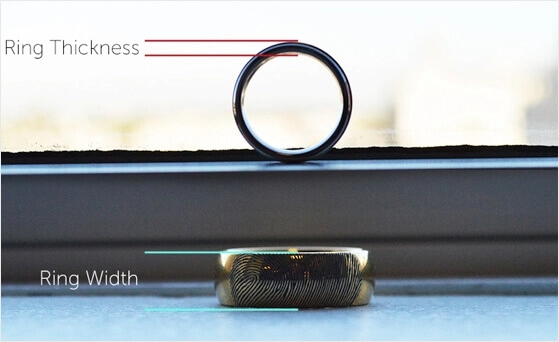SHOP PAY PAYMENT PLANS AVAILABLE. FREE SHIPPING ON YOUR ORDER TODAY!
Ring Thickness vs. Ring Width

When picking out an engagement or wedding ring, there's more to consider than just color and material. You also want to make sure you choose the right width and thickness. Larson Jewelers is here to help you figure what exactly ring width and ring thickness mean, what the difference between the two is and how they can be used to find the perfect ring.
There is no standard measurement for a ring's thickness and many manufacturers create rings that highly vary in thickness, but if the thickness of a ring concerns you, your jeweler should be able to measure the exact thickness of a ring with a caliper. A good rule to follow would be that the wider the width of a ring, the thicker the ring will be.
What ring thicknesses are available?
Ring thickness refers to the thickness of a ring's profile (see diagram to the right). The width of a tungsten ring and thickness of a ring may seem to have the same meaning but actually reference very different attributes of a ring and are not interchangeable. Rings are most commonly sold based on their width, and thickness can vary based on the manufacturer, but the thickness will likely correlate with the width.
What ring widths are available?
Industry standard ring widths are even and include 2mm, 4mm, 6mm, 8mm, 10mm, 12mm and 20mm. More uncommon widths that are available for certain styles or by custom request are 5mm, 7mm and the very wide 20mm width. There is a simple visual below that shows our standard widths offered. You can learn a lot more about ring widths from our ring width guide, and if you'd like to see a video representation and on-hand photo representations of ring widths, you can visit our visual ring width guide.

How wide/thick should your ring be?
There are no rules when it comes to what ring width or thickness you should wear, regardless of purpose or material, but there are very common traditions that have been accepted as the "proper" ring width based on gender.
Ring widths of 6mm and smaller are considered a women's ring width range. Ring widths of 8mm and greater are considered a man's ring width range. Smaller widths for women are generally due to bands being worn alongside diamond engagement rings. Too large of a width, and the appearance of a wedding band and engagement ring side by side might appear too large and may not fit most fingers.
Remember, the wider the ring is, the thicker the ring will be, and ring thickness varies depending on manufacturer. You'll want to keep this and any personal preferences in mind while shopping for rings. If you or the person you're shopping for prefers thinner rings, then you'll want to look at rings that are narrower, and if you like thick rings, you'll want to look at options that are wider.
Do I have to follow the norm?
The honest, simple answer to this question is absolutely not! We have had a multitude of customers from both genders purchase ring widths in all ranges and different thicknesses from multiple manufacturers.
There are also many reasons not to follow ring width tradition as well. A 6mm width or smaller might be a great fit for a man with smaller hands and thinner fingers since traditional men's widths may appear too thick. The same argument can be made for women with larger hands and fingers who may feel an 8mm or thicker width may be a better fit. We have everything from delicate engagement rings with thin bands to thick diamond band rings to match every unique taste. Larger ring widths are also worn for modern appeal, which is why 10mm, 12mm and 20mm ring widths are purchased very often not just for weddings, but for style and fashion.
